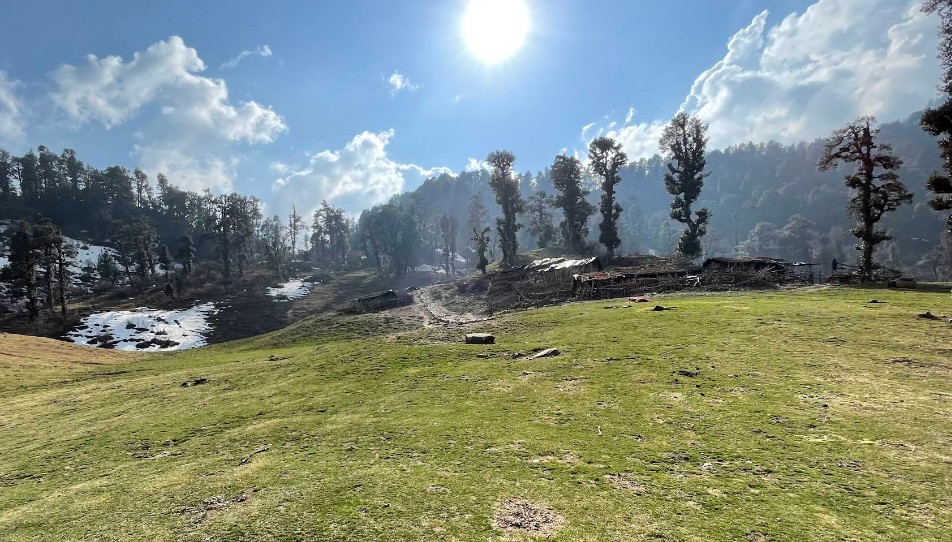ndia’s natural beauty often conjures images of majestic mountains, dense jungles, and serene beaches. Yet nestled between these grand landscapes lies one of India’s most underappreciated natural wonders—its grasslands. These vibrant ecosystems, often referred to as the "Wild Heart of India," are teeming with life, color, and history. Join us on a journey through some of India’s most iconic grasslands and discover the wild soul of the subcontinent.
What Are Grasslands?
Grasslands are open landscapes dominated by grasses rather than large shrubs or trees. In India, they are found in diverse forms—semi-arid grasslands of central and western India, montane grasslands in the Western Ghats and Himalayas, and floodplain grasslands of the northeast.
Far from being barren or lifeless, grasslands are among the most productive and biodiverse ecosystems on the planet. They support a range of wildlife, from large predators to tiny insects, and play a vital role in India’s ecological balance.
1. Velavadar Blackbuck National Park – Gujarat
Home of the Blackbuck
Velavadar is India’s first national park dedicated to grassland conservation. Located in Gujarat, this golden savanna is famous for its healthy population of blackbucks, the graceful antelope species known for their spiraled horns and incredible speed.
Highlights:
- Endangered Indian wolves and striped hyenas
- Over 140 species of birds, including harriers and flamingos
- Best time to visit: October to March
2. Kanha Meadows – Madhya Pradesh
Where Tigers Roam the Grasslands
While Kanha National Park is famous for its tigers, its sprawling meadows are what truly make it unique. These open stretches of grass surrounded by sal forests provide an ideal hunting ground for predators.
Highlights:
- Barasingha (swamp deer), a conservation success story
- Excellent tiger and leopard sightings
- Rich cultural connection with local Baiga tribes
3. Banni Grasslands – Gujarat
The Desert’s Lush Secret
Located on the edge of the Rann of Kutch, Banni is one of the largest tropical grasslands in Asia. It supports a unique mix of dry grassland species and desert wildlife.
Highlights:
- Thriving pastoral culture of the Maldhari community
- Habitat for wildcats, desert foxes, and flamingos
- Host of the Rann Utsav festival
4. Dayara Bugyal – Uttarakhand
India’s Most Picturesque Alpine Meadow
Perched at an altitude of around 11,000 feet in the Uttarkashi district, Dayara Bugyal is a vast alpine grassland blanketed in green during summer and snow during winter. It offers a magical trekking experience through oak forests, high-altitude meadows, and panoramic Himalayan views.
Highlights:
- Ideal for beginners and experienced trekkers alike
- Panoramic views of Bandarpoonch, Draupadi Ka Danda, and Black Peak
- Rich in seasonal flora and high-altitude birds
- Best time to visit: May–June and September–October
5. Corbett’s Chaurs – Uttarakhand
Grasslands of the Himalayan Foothills
The chaurs or grasslands of Jim Corbett National Park are scenic and teeming with wildlife. They are perfect habitats for elephants, deer, and predatory cats.
Highlights:
- Elephant herds, tiger sightings, and bird diversity
- A great mix of forest and grassland landscape
- Safari options including jeep and canter
6. Shola Grasslands – Western Ghats
A Cloud-Kissed Wonder
These montane grasslands, interspersed with Shola forests, thrive in the misty highlands of the Western Ghats in Kerala, Tamil Nadu, and Karnataka. They're vital for endemic species and are incredibly scenic.
Highlights:
- Nilgiri tahr and lion-tailed macaques
- Trekking in Eravikulam, Kudremukh, and Nilgiris
- UNESCO World Heritage Site status
7. Dibru-Saikhowa – Assam
The Floodplain Grassland
Dibru-Saikhowa National Park is located in the floodplains of the Brahmaputra River. Its grasslands and wetlands provide refuge to many rare and migratory species.
Highlights:
- Feral horses and river dolphins
- Birding paradise with over 300 species
- River island safaris and boat tours
8. Tal Chhapar – Rajasthan
Rajasthan’s Serengeti
Nestled in the Shekhawati region, Tal Chhapar is a tiny yet spectacular grassland famous for blackbucks and raptors.
Highlights:
- Migratory birds like harriers, kestrels, and eagles
- Golden-hued sunsets and photography opportunities
- Best time: September to March
9. Son Chiriya Sanctuary—Madhya Pradesh
A Bastion for the Indian Bustard
Located in the Chambal region, this sanctuary protects another population of the endangered Great Indian Bustard.
Highlights:
- Grassland and ravine ecosystem
- Indian wolf, caracal, and monitor lizards
- Lesser explored and full of raw charm
10. Satpura Grasslands – Madhya Pradesh
Underrated Wilderness
Part of the Satpura Tiger Reserve, these grasslands offer solitude and a rare wilderness experience away from the crowds.
Highlights:
- Sloth bears, leopards, and gaur
- Boat safaris, walking trails, and mobile camps
- Best for eco-tourism lovers
Why India’s Grasslands Matter
Despite their importance, grasslands in India are often misclassified as "wastelands" and face threats from agriculture, afforestation, and urbanization. Yet, they are:
- Crucial carbon sinks
- Home to unique wildlife
- Culturally important to pastoralist and tribal communities
- Vital for water conservation and soil health
Conservation Challenges
Efforts must focus on:
- Recognizing grasslands as distinct ecosystems
- Protecting habitats of endangered species like the Great Indian Bustard
- Supporting traditional communities and sustainable tourism
Tips for Exploring India’s Grasslands
- Best season: October to March (cooler months)
- Go with a local guide to understand the ecology and culture
- Carry binoculars and a camera—you’ll regret it if you don’t!
- Respect local customs and avoid littering
Conclusion: The Wild Heart Beats On
India’s grasslands are not just open spaces—they are living landscapes full of stories, struggles, and survival. From the highland Sholas to the golden plains of Gujarat, these ecosystems pulse with life. As we celebrate India’s wilderness, let’s not forget its grassy heart, where the wind carries the whispers of antelope hooves, eagle cries, and tribal songs.
Let your next wild journey lead you where the grass sways freely, and the wild spirit of India thrives.





Comments